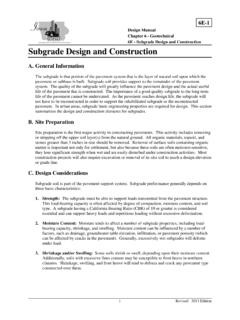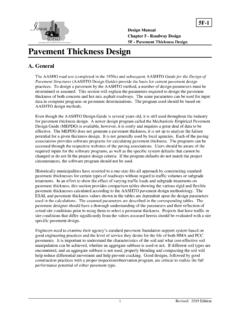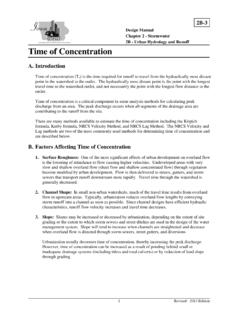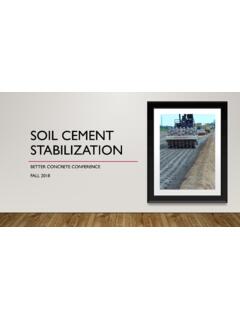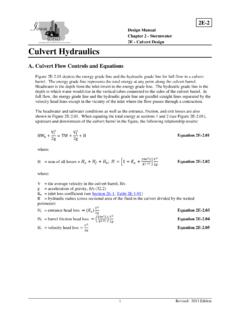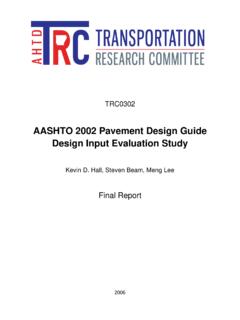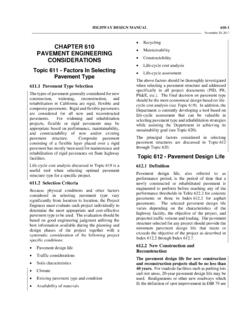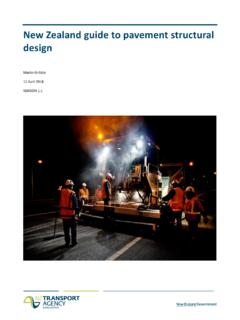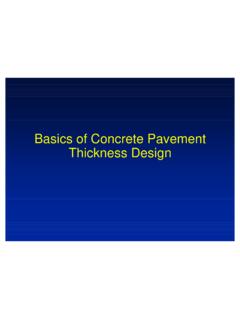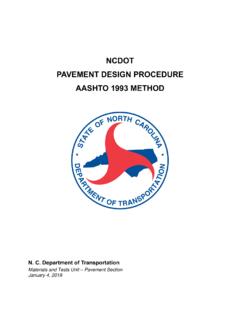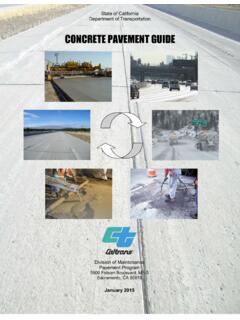Transcription of Section 6F-1 - Pavement Subbase Design and Construction
1 6F-1. Design Manual Chapter 6 - Geotechnical 6F - Pavement Subbase Design and Construction Pavement Subbase Design and Construction A. General Information Pavement systems generally consist of three layers: prepared subgrade, Subbase , and Pavement . This Section will deal with the proper Design and Construction of subbases. The Subbase is the layer of aggregate material that lies immediately below the Pavement and usually consists of crushed aggregate or gravel or recycled materials (see Section 6C-1 - Pavement Systems for more information). Although the terms base and Subbase are sometimes used interchangeably to refer to the subsurface layers of a Pavement , base course is typically used in asphalt pavements, primarily as a structural load-distributing layer, whereas the Subbase layer used in concrete pavements primarily serves as a drainage layer.
2 Aggregate Subbase is typically composed of crushed rock, comprised of material capable of passing through a 1 1/2 inch screen, with component particles varying in size from 1 1/2 inch down to dust. The material can be made of virgin (newly mined) rock or of recycled asphalt and concrete. The function of the Pavement Subbase is to provide drainage and stability to achieve longer service life of the Pavement . Most Pavement structures now incorporate subsurface layers, part of whose function is to drain away excess water that can be deleterious to the life of the Pavement (see Section 6G-1 - Subsurface Drainage Systems). However, aggregate materials for permeable bases must be carefully selected and properly constructed to provide not only permeability, but uniform stability as well.
3 Proper Construction and QC/QA testing operations can help to ensure good performance of the Subbase layer. Excessive compaction can alter the gradation and create additional fines that may result in lower permeabilities than determined in laboratory tests and used in the Pavement system Design . However, the optimization of structural contributions from high stability, versus the need to provide adequate drainage for Pavement materials is still a point of debate. The focus of this Section is to provide guidance on selection of proper Subbase materials, best Construction practices, and suitable QC/QA testing methods. B. Granular Subbases 1. Purpose: Subbases serve a variety of purposes, including reducing the stress applied to the subgrade and providing drainage for the Pavement structure.
4 The granular Subbase acts as a load- bearing layer, and strengthens the Pavement structure directly below the Pavement surface, providing drainage for the Pavement structure on the lowest layer of the Pavement system. However, it is critical to note that the Subbase layer will not compensate for a weak subgrade. Subgrades with a CBR of at least 10 should provide adequate support for the Subbase . 2. Materials: As the granular Subbase provides both bearing strength and drainage for the Pavement structure, proper size, grading, shape, and durability are important attributes to the overall performance of the Pavement structure. Granular Subbase aggregates consist of durable particles of crushed stone or gravel capable of withstanding the effects of handling, spreading, and compacting without generation of deleterious fines.
5 1 Revised: 2013 Edition Chapter 6 - Geotechnical Section 6F-1 - Pavement Subbase Design and Construction 3. Gradation: Aggregates used as Subbase tend to be dense-graded with a nominal maximum size, commonly up to 1 1/2 inches. The percentage of fines (passing No. 200 sieve) in the Subbase is limited to 10% for drainage and frost-susceptibility purposes. The Engineer may authorize a change in the gradation at the time of Construction based on materials available. a. Particle Shape: Equi-dimensional aggregate with rough surface texture is preferred. b. Permeability: The fines content is usually limited to a maximum of 10% for normal Pavement Construction and 6% where free-draining Subbase is required.
6 C. Plasticity: Plastic fines can significantly reduce the load carrying capacity of Subbase ;. plasticity index (PI) of the fines of 6 or less is required. 4. Construction : Granular subbases are typically constructed by spreading the materials in thin layers compacting each layer by rolling over it with heavy compaction equipment to achieve a density greater or equal to 70% relative density. 5. Thickness Requirement: Typically, the thickness of the Subbase is 6 inches with a minimum of 4 inches. Additional thickness beyond 6 inches could allow consolidation of the Subbase over time as traffic loads accumulate. Pavement problems may result from this consolidation.
7 C. Recycled Materials Recycled materials with the required particle distribution, high stiffness, low susceptibility to frost action, high permeability, and high resistance to permanent deformation can be successful subbases. Recycled aggregate can solve disposal problems, conserve energy, and lower the cost of road Construction . 1. Recycled Concrete Aggregate: To reduce the use of natural aggregate and help preserve the environment, recycled concrete aggregate can be used. Consider the following precautions: The breakage of particles results in faces, which can react with water and produce high pH. This may result in poor freeze-thaw performance. The breakage of particles due to compaction and traffic loading will increase the fines percentage.
8 This increasing fine percentage will reduce freeze-thaw resistance and permeability of bases. Increased pH due to cement hydration can cause corrosion of aluminum and steel pipes. 2. Recycled Asphalt Pavement : Consider the following precautions. 20% to 50% RAP is typically used. High percentages of RAP are not used in normal Construction . The stiffness increases with higher percentage of RAP, while there must be limits on percentage of RAP to incorporate into virgin material. 2 Revised: 2013 Edition Chapter 6 - Geotechnical Section 6F-1 - Pavement Subbase Design and Construction D. Effects of Stability and Permeability on Pavement Foundation The Subbase is the layer of aggregate material that lies immediately below the Pavement and usually consists of crushed aggregate or recycled materials.
9 1. The Main Roles of the Subbase Layer in Pavements: Include provision of the following (Dawson 1995). Protection for the subgrade from significant deformation due to traffic loading Adequate support for the surface layer Stable Construction platform during Pavement surfacing Adequate drainage for the infiltration of rain water through cracks and joints, particularly in PCC pavements (see Section 6G-1 - Subsurface Drainage Systems). Subgrade protection against frost and environmental damage 2. Effect of Undrained Water on Pavement Foundation: Undrained water in the Pavement supporting layers is a major contributor to distress and premature failure in pavements.
10 Some of the detrimental effects of water, when entrapped in the pavements structure are that (Yang 2004): Water reduces the strength of unbounded granular materials and subgrade soils. Water causes pumping of concrete pavements with subsequent faulting, cracking, and general shoulder deterioration. With the high hydrodynamic pressure generated by moving traffic, pumping of fines in the base course of flexible pavements may also occur with resulting loss of support. In northern climates with a depth of frost penetration greater than the Pavement thickness, high water table causes frost heave and the reduction of load-carrying capacity during the frost melting period.
